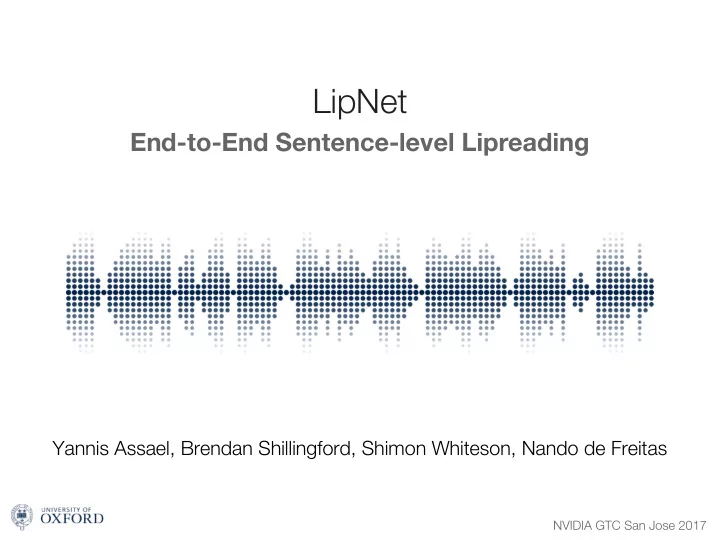

LipNet End-to-End Sentence-level Lipreading Yannis Assael, Brendan Shillingford, Shimon Whiteson, Nando de Freitas NVIDIA GTC San Jose 2017
Outline 1. Introduction 2. Background 3. LipNet 4. Analysis
1. Introduction How easy do you think lipreading is? • McGurk effect (McGurk & MacDonald, 1976) • Phonemes and Visemes (Fisher, 1968) • Human lipreading performance is poor We can improve it… 3 /21
1. Introduction https://goo.gl/hyFBVQ 4 /21
1. Introduction Why is lipreading important? Among others: -Improved hearing aids -Speech recognition in noisy environments (e.g. cars) -Silent dictation in public spaces -Security -Biometric identification -Silent-movie processing 5 /21
1. Introduction https://goo.gl/RTXh9Q 6 /21
1. Introduction Automated lipreading • Most existing work does not employ deep learning • Heavy preprocessing • Open problems: • generalisation across speakers • extraction of motion features 7 /21
2. Background End-to-end supervised learning using NNs 1. Hierarchical, expressive, differentiable function Layer 1 Layer 2 Layer L predictive input distribution 1. Adjust parameters to maximise probability of data with gradient descent 8 /21
2. Background Convolutional Neural Networks • Model: Deep stacks of local operations. • Good for: relationships over space (2D) : deeplearning.net • Also good for time (1D) • Or in our case, space & time (3D) : every layer can model either or both. Lets the optimisation decide what's best. 9 /21
2. Background Recurrent Neural Networks • Model: carry information over time using a state • Good for: sequences • Often used to predict classes at each timestep • But what if inputs/outputs are unequal length, or aren't aligned? 10 /21
2. Background Recurrent Neural Networks • If inputs/outputs aren't aligned, CTC (Graves 2006) efficiently marginalises over all alignments • To do this, let the RNN output blanks or duplicates : • Sum over every way to output the same sequence: p( am ) = p(aam) + p(amm) + p(_am) + p(a_m) + p(am_) 11 /21
3. LipNet LipNet • Monosyllabic vs Compound words (Easton & Basala, 1982) • Spatiotemporal features • End-to-end, sentence-level • GRID corpus 33000 sentences 12 /21
3. LipNet GRID corpus 13 /21
3. LipNet Preprocessing • Facial Landmarks • Crop the mouth • Affine transform the frames • Smoothen using Kalman filter • Temporal augmentation 14 /21
3. LipNet Model Architecture 15 /21
3. LipNet Baselines • Hearing-Impaired People 3 students from the Oxford Students’ Disability Community • Baseline-LSTM Replicate previous state-of-the-art architecture by (Wand et al., 2016) • Baseline-2D Spatial-only convolutions • Baseline-NoLM Language model disabled 16 /21
3. LipNet Lipreading Performance Unseen Overlapped Speakers Speakers CER WER CER WER Hearing 47.7% Impaired Baseline- 38.4% 52.8% 15.2% 26.3% LSTM Baseline- 16.2% 26.7% 4.3% 11.6% 2D Baseline- 6.7% 13.6% 2.0% 5.6% NoLM 6.4% 11.4% 1.9% 4.8% LipNet 17 /21
4. Analysis Learned Representations 18 /21
4. Analysis Viseme Confusions 19 /21
Thank you!
Thank you NVIDIA! DGX-1
Recommend
More recommend